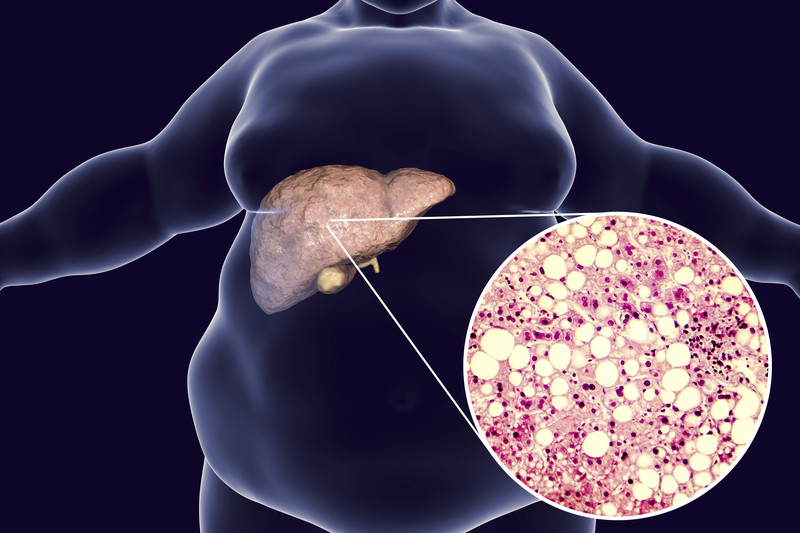How does obesity lead to fatty liver disease?

However, there are many factors to consider in that regard to properly understand how this occurs. Thus, if you are suffering from fatty liver disease, you would notice a correlation between non-alcoholic fatty liver disease treatment and obesity as well.
What is obesity?
Obesity is currently one of the most common health issues visible in adult men and women across the world. In fact, it is one of the most harmful and prominent conditions people in the developed countries deal with, especially the US. It is visible in around half the citizens in this country, and more; and reports have attributed around 300,000 deaths to it.
To be precise, this condition means that there is an extreme amount of fat deposits inside the body. Men with above 25% body fat and women with more than 30% body fat fall under the obese category. Moreover, they are susceptible to many other health issues too, some with deadly consequences.
Some of these conditions include growing resistance to insulin, type 2 diabetes, gout, colon cancer, gallstones, sleep apnea, etc. Furthermore, you would also notice many of the Non-alcoholic Fatty Liver Disease Symptoms because of obesity. Also, this condition causes heart issues that can lead to stroke or heart attack, like cerebrovascular disease and coronary heart disease, respectively.
What is a nonalcoholic fatty liver disease (NAFLD)?
Among the most common causes of liver diseases, the overuse of alcohol is one of the leading reasons. It results in fat accumulation inside the liver, and that makes its normal functioning difficult. However, it is not the only cause for fatty liver; non-alcoholic reasons like obesity, too, are a major reason behind this.
Thus, non-alcoholic fatty liver disease or NAFLD involves many varieties of repercussions and causes. Also, it has different types that occur in both adults and children, including steatosis, cirrhosis, or nonalcoholic steatohepatitis (NASH). Each of them affects different parts of the liver in seperate ways.
The first one is when the fat deposits increase inside the liver. Cirrhosis occurs when there is scarring inside of the liver due to certain damages. In fact, this is a serious version of NAFLD and usually, there is no treatment for it. However, some Ayurvedic medicines do work in reducing the effects of it on the health, and the consequent pain. As for NASH, that happens when the fat deposits that are in the liver result in inflammation and consequent symptoms.
Effects of obesity on liver
Without a doubt, obesity does affect the body in harmful ways, and it is one of the main Non-alcoholic Fatty Liver Disease Causes. Due to certain lifestyle decisions, genetics, eating disorders, etc., many people start suffering from obesity. Consequently, a lot of them get Type 2 diabetes as well, and they build up immunity to insulin. And this is a very important factor to consider.
After all, there is a certain limit to how much the pancreas can produce and secrete insulin in a timely manner. The cholesterol levels and blood sugar levels get controlled via this, and that allows for healthy bodily operation. However, when the body fat percentage increases in the body, the person loses energy faster and their mobility rate also reduces.
Owing to this, the fat percentage surpasses the frequency of the amount of insulin that the pancreas makes. Then, that leads to more fat-depositing inside the liver, which results in NAFLD later. The liver itself cannot work effectively to reduce the cholesterol or blood sugar in the bloodstream. This results in more fat accumulation, which further causes inflammation.
Without timely allopathic or homeopathic treatment for nonalcoholic fatty liver disease, this condition can get worse. And that results in serious damage to the liver; and in worse-case scenarios, liver cirrhosis or cancer. At this point, the liver is beyond any type of repair, though homeopathic medicine can reduce the pain to some extent.
Genes, too, form one of the main reasons for NAFLD, besides food-induced obesity, and is another cause for obesity itself. Additionally, it is important to mention that alcohol has no influence on this type of fatty liver disease. In fact, people who have obesity without drinking any alcohol mainly showcase symptoms from this type of liver disease.
Statistical analysis
To put it simply, non-alcoholic fatty liver disease is a more prominent form of this disease than the alcoholic version. In fact, statistically, those living in more developed countries have a higher likelihood of needing nonalcoholic fatty liver disease and obesity treatment. This is mainly due to the lifestyle they are used to, and easier access to fast food and other fatty dietary items.
Not to mention, most people in such countries do not need to do much physical labor, which reduces their weight-loss potential. Thus, throughout the world, around 10% to 24% of the total human population shows signs of obesity. In the United States alone, around one-quarter of the people are obese and half of the people are overweight, as per the BMI calculator. Indeed, BMI or Body Mass Index is the standard measurement for body weight. It looks into the balance of your height and weight to calculate obesity.
Thus, there are more than millions of people around the world who suffer from nonalcoholic fatty liver disease and its several types. In fact, this issue is not limited to adults only; many growing children, too, suffer from this condition. This is not a healthy sign, as the consequences of this disease can result in life-threatening liver illnesses and failure.
One of the most worrying parts of this condition is that it is slow-building. As a result, symptoms are rarely visible early, which does not leave much room for faster diagnosis. According to most reports, the usual moment when the diagnosis and management for nonalcoholic fatty liver disease take place is during other routine checkups.
Certainly, it is better to focus on maintaining a better lifestyle from the beginning itself to combat the later stages. Ayurvedic medicine does work well in such measures, while exercise and diet are other factors doctors recommend. When the NAFLD matures into cirrhosis, no treatment methods are effective any longer.
Can it get treated?
To put it simply, the main treatment plan that works in the case of fatty liver disease due to obesity is through diet. After all, excessive weight gain causes this disease, and maintaining a healthy food intake would result in better body shape. Also, exercising is another major lifestyle factor that you need to include in order to protect yourself from fatty liver diseases.
Thus, a proper nonalcoholic fatty liver disease treatment diet is both a treatment plan and a prevention plan in this scenario. Doctors prescribe their patients to include certain food nutrients in their everyday meal plans and limit carbohydrate intake. However, completely disregarding it would not work well for a healthier body as this food group does have essential qualities.
Additionally, entering food products like green vegetables and protein would also alter your liver conditions positively. In the case of the latter, the doctors would recommend lean meat, fish, low-fat dairy, etc., for your diet. Homeopathic and herbal medicine, too, can affect the healthier functioning of your liver.
In the case of attacking the other factors that affect obesity, like insulin, there are some medications that are available. Some doctors use drugs like Lipitor to improve enzyme production and reduce bad cholesterol (LDL). Similarly, insulin-sensitizing agents like Metformin, rosiglitazone, thiazolidinediones, etc., are better for those with Type-2 diabetes.
This is mainly because these agents can monitor the glucose level in the blood and help in liver protection. Also, these drugs do help in controlling the enzyme levels too, and thus, it is worth considering. However, these are not the direct cures for NAFLD but they do stabilize the patient and their liver vitals.
To summarize, obesity is a major factor that is responsible for fatty liver disease, even if the patient is not an alcoholic. It has other effects, too, that can seriously hamper the health factor of the liver and subsequently the entire body. And in most cases, the ultimate outcome is life-threatening and requires liver transplantation. A huge number of people suffer the consequences of obesity, including younger kids. Although matters like surgery or medication cannot completely cure fatty liver disease, following a better lifestyle can improve the conditions regardless.
Was this answer helpful for you?
[WPAC_LIKE_SYSTEM]
Answered By
Was this answer helpful for you?
[WPAC_LIKE_SYSTEM]
Must Read
How can jaundice be treated during pregnancy
Jaundice is a condition that occurs in people as a symptom of other issues and is visible via a yellowing in their body. To be specific, this yellow discoloration happens in the...
How can jaundice be treated during pregnancy
Jaundice is a condition that occurs in people as a symptom of other issues and is visible via a yellowing in their body. To be specific, this yellow discoloration happens in the...
Reviews All Reviews
“I was diagnosed with Liver Cirrhosis in March 2016 in Sangali City. I was absolutely shocked, as I never expected this to happen to that and me to this soon. We met Dr. Bipin B Vibhute and he answered all our queries and questions with absolute patience that we understood I need a transplant.”
“A broken marriage followed by self-pity made me a drunker. Excessive consumption of alcohol was the reason due to which my liver got damaged. The damage was so severe that a liver transplant was the only option if I wanted to live. I have been extremely fortunate to get three chances in life. I have been…”
Doctors Meet Our Team






